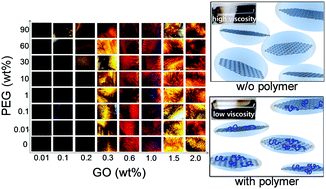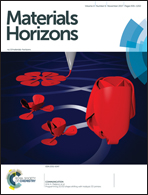Wide concentration liquid crystallinity of graphene oxide aqueous suspensions with interacting polymers†
Abstract
Graphene oxides (GOs), an oxygenated derivative of graphene, spontaneously undergo monolayer exfoliation in water, and thus, form liquid crystalline (LC) suspensions. Unfortunately, the resultant suspensions vitrify at around a 1 wt% composition, which commonly acts as an obstacle for GO-based material fabrication, while degrading the molecular ordering and relevant material properties. Here, we systematically investigate the phase behaviour and structural evolution of GO LC suspensions under various experimental conditions and disclose how the glass transition of GO dispersions is affected particularly in the presence of strongly interacting polymers. The supplementary polymer additives can effectively retard the ‘glass transition’ of a GO suspension, broaden the concentration range for a nematic LC phase toward lower and higher concentration ranges and dramatically decrease the viscosity of the suspension down to the 1/100–1/1000 level. Extensive small-angle X-ray scattering and rheological measurements are employed to characterize the molecular level GO structures in LC suspensions.

- This article is part of the themed collection: Horizons Community Board Collection – Emerging 2D Materials for Energy and Electronics Applications


 Please wait while we load your content...
Please wait while we load your content...